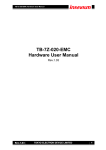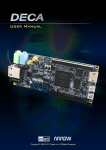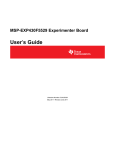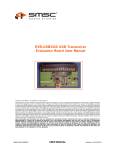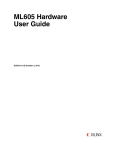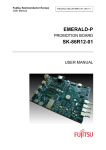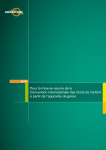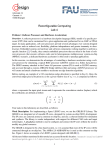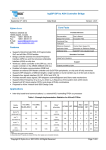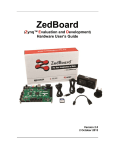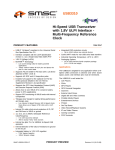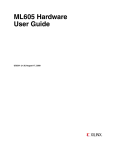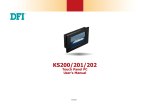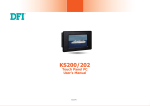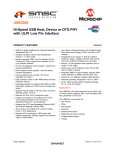Download TB-7Z-020-EMC Hardware User Manual
Transcript
TB-7Z-020-EMC Hardware User Manual TB-7Z-020-EMC Hardware User Manual Rev.0.90 Rev.0.90 1 TB-7Z-020-EMC Hardware User Manual Revision History Version Date Description Publisher Rev 0.90 2013/01/31 Preliminary Version Yoshioka Rev.0.90 2 TB-7Z-020-EMC Hardware User Manual Table of Contents 1. 2. 3. 4. 5. 6. 7. Related Documents and Accessories ......................................................................................... 9 Overview ...................................................................................................................................... 9 Feature ........................................................................................................................................ 9 Block Diagram ........................................................................................................................... 10 External View of the Board .........................................................................................................11 Board Specifications .................................................................................................................. 12 Description of Components ....................................................................................................... 14 7.1. Power Supply Structure ............................................................................................................ 14 7.1.1. DC Jack Connector ........................................................................................................... 14 7.1.2. FP_VCCO_ADJ SEL Jumper ........................................................................................... 15 7.1.3. VCC_ADJ SEL Jumper ..................................................................................................... 15 7.2. Clock System ........................................................................................................................... 16 7.3. On-board PLL ........................................................................................................................... 16 7.4. I2C BUS.................................................................................................................................... 17 7.5. Memory..................................................................................................................................... 18 7.5.1. DDR3 ................................................................................................................................ 18 7.5.2. QSPI Flash ....................................................................................................................... 18 7.5.3. SD Card Interface ............................................................................................................. 19 7.6. 10/100/1000 Ethernet PHY ...................................................................................................... 20 7.7. UART Interface ......................................................................................................................... 21 7.8. CAN BUS.................................................................................................................................. 21 7.9. USB OTG ................................................................................................................................. 22 7.9.1. 7.10. RTC ...................................................................................................................................... 23 7.11. Pmod .................................................................................................................................... 24 7.11.1. 7.12. 7.12.1. Pmod Power Supply SEL Jumper .................................................................................... 24 Mictor 38 ............................................................................................................................... 25 VTREF SEL Jumper ......................................................................................................... 25 7.13. JTAG ..................................................................................................................................... 26 7.14. Reset Switches ..................................................................................................................... 27 7.15. DVI Output ............................................................................................................................ 28 7.16. FMC Connector Interface ..................................................................................................... 29 7.16.1. FMC Low-Pin Count Mezzanine Card (CN4) connector. .................................................. 30 7.16.2. FMC Low-Pin Count Carrier Card (CN5) connector. ........................................................ 32 7.17. 7.17.1. 8. USB VBUS Power Supply SEL Jumper............................................................................ 22 Jumper .................................................................................................................................. 34 Boot Mode Settings .......................................................................................................... 34 7.18. LED ....................................................................................................................................... 35 7.19. Push Switch .......................................................................................................................... 36 7.20. Dip Switches ......................................................................................................................... 37 Default Settings ......................................................................................................................... 38 Rev.0.90 3 TB-7Z-020-EMC Hardware User Manual List of Figures Figure 4-1 Block Diagram ................................................................................................................ 10 Figure 5-1 Component Side ..............................................................................................................11 Figure 5-2 Solder Side ......................................................................................................................11 Figure 6-1 Board Dimensions (inclusive of wastable substrate, top view) ....................................... 13 Figure 6-2 Board Dimensions (inclusive of wastable substrate, bottom view) ................................. 13 Figure 7-1 Power Supply Structure .................................................................................................. 14 Figure 7-2 DC Jack Connector ......................................................................................................... 14 Figure 7-3 FP_VCCO_ADJ SEL Jumper ......................................................................................... 15 Figure 7-4 VCC_ADJ SEL Jumper ................................................................................................... 15 Figure 7-5 Clock System Diagram ................................................................................................... 16 Figure 7-6 I2C Bus Topology ............................................................................................................ 17 Figure 7-7 DDR3 Memory Connection ............................................................................................. 18 Figure 7-8 QSPI Connection ............................................................................................................ 18 Figure 7-9 SD Card Slot Connection................................................................................................ 19 Figure 7-10 RGMII Connection ........................................................................................................ 20 Figure 7-11 RJ-45 internal LED ........................................................................................................ 20 Figure 7-12 UART Connection ......................................................................................................... 21 Figure 7-13 CAN Connection ........................................................................................................... 21 Figure 7-14 RS-232C/CAN Cable connection ................................................................................. 21 Figure 7-15 USB Connection ........................................................................................................... 22 Figure 7-16 USB VBUS Power Supply SEL Jumper........................................................................ 22 Figure 7-17 RTC Connection ........................................................................................................... 23 Figure 7-18 Pmod Connection ......................................................................................................... 24 Figure 7-19 Pmod Port’s Power SEL Jumper .................................................................................. 24 Figure 7-20 MICTOR 38 Connection ............................................................................................... 25 Figure 7-21 ARM PJTAG Port’s VTREF SEL Jumper ...................................................................... 25 Figure 7-22 JTAG Connection .......................................................................................................... 26 Figure 7-23 XC7Z020's Software Reset Push Switch...................................................................... 27 Figure 7-25 DVI Connection ............................................................................................................. 28 Figure 7-26 FMC LPC Pin List ......................................................................................................... 29 Figure 7-27 User Push Switch ......................................................................................................... 36 Figure 7-28 User Dip Switch ............................................................................................................ 37 Figure 7-29 PLL Setting Dip Switch ................................................................................................. 37 Rev.0.90 4 TB-7Z-020-EMC Hardware User Manual List of Tables Table 7-1 Power Setting ................................................................................................................... 15 Table 7-2 I2C Address Map .............................................................................................................. 17 Table 7-3 RJ-45 internal LED Function Table................................................................................... 20 Table 7-4 USB Settings .................................................................................................................... 22 Table 7-5 Pmod Power Setting ......................................................................................................... 24 Table 7-6 Jumper Function Table ..................................................................................................... 26 Table 7-7 FMC LPC MC Connector pin assignment table (CN4)..................................................... 30 Table 7-8 FMC LPC CC Connector pin assignment table (CN5) ..................................................... 32 Table 7-9 All Jumpers Function Table .............................................................................................. 34 Table 7-10 Boot Mode Settings ........................................................................................................ 34 Table 7-11 LED Function Table ........................................................................................................ 35 Table 7-12 Push Switch Function Table ........................................................................................... 36 Table 7-13 Dip Switch Function Table .............................................................................................. 37 Table 8-1 Default Jumper Settings ................................................................................................... 38 Table 8-2 Default Switch Settings .................................................................................................... 38 Rev.0.90 5 TB-7Z-020-EMC Hardware User Manual Introduction Thank you for purchasing the TB-7Z-020-EMC board. Before using the product, be sure to carefully read this user manual and fully understand how to correctly use the product. First read through this manual, then always keep it handy. SAFETY PRECAUTIONS Be sure to observe these precautions Observe the precautions listed below to prevent injuries to you or other personnel or damage to property. Before using the product, read these safety precautions carefully to assure correct use. These precautions contain serious safety instructions that must be observed. After reading through this manual, be sure to always keep it handy. The following conventions are used to indicate the possibility of injury/damage and classify precautions if the product is handled incorrectly. Danger Indicates the high possibility of serious injury or death if the product is handled incorrectly. Indicates the possibility of serious injury or death if the product is handled Warning incorrectly. Indicates the possibility of injury or physical damage in connection with houses or Caution household goods if the product is handled incorrectly. The following graphical symbols are used to indicate and classify precautions in this manual. (Examples) Turn off the power switch. Do not disassemble the product. ! Rev.0.90 Do not attempt this. 6 TB-7Z-020-EMC Hardware User Manual Warning In the event of a failure, disconnect the power supply. If the product is used as is, a fire or electric shock may occur. Disconnect the power supply immediately and contact our sales personnel for repair. If an unpleasant smell or smoking occurs, disconnect the power supply. If the product is used as is, a fire or electric shock may occur. immediately. Disconnect the power supply After verifying that no smoking is observed, contact our sales personnel for repair. Do not disassemble, repair or modify the product. Otherwise, a fire or electric shock may occur due to a short circuit or heat generation. For inspection, modification or repair, contact our sales personnel. ! Do not touch a cooling fan. As a cooling fan rotates in high speed, do not put your hand close to it. cause injury to persons. ! Otherwise, it may Never touch a rotating cooling fan. Do not place the product on unstable locations. Otherwise, it may drop or fall, resulting in injury to persons or failure. If the product is dropped or damaged, do not use it as is. Otherwise, a fire or electric shock may occur. ! Do not touch the product with a metallic object. ! Do not place the product in dusty or humid locations or where water may Otherwise, a fire or electric shock may occur. splash. Otherwise, a fire or electric shock may occur. ! ! Do not get the product wet or touch it with a wet hand. Otherwise, the product may break down or it may cause a fire, smoking or electric shock. Do not touch a connector on the product (gold-plated portion). Otherwise, the surface of a connector may be contaminated with sweat or skin oil, resulting in contact failure of a connector or it may cause a malfunction, fire or electric shock due to static electricity. Rev.0.90 7 TB-7Z-020-EMC Hardware User Manual Caution Do not use or place the product in the following locations. ! Humid and dusty locations Airless locations such as closet or bookshelf Locations which receive oily smoke or steam Locations exposed to direct sunlight Locations close to heating equipment Closed inside of a car where the temperature becomes high Staticky locations Locations close to water or chemicals Otherwise, a fire, electric shock, accident or deformation may occur due to a short circuit or heat generation. ! Do not place heavy things on the product. Otherwise, the product may be damaged. Disclaimer This product is an evaluation board for Xilinx Zynq AP SoC FPGA. Tokyo Electron Device Limited assumes no responsibility for any damages resulting from the use of this product for purposes other than those stated. Even if the product is used properly, Tokyo Electron Device Limited assumes no responsibility for any damages caused by: (1) Earthquake, thunder, natural disaster or fire resulting from the use beyond our responsibility, acts by a third party or other accidents, the customer’s willful or accidental misuse or use under other abnormal conditions. (2) Secondary impact arising from use of this product or its unusable state (business interruption or others) (3) Use of this product against the instructions given in this manual. (4) Malfunctions due to connection to other devices. Tokyo Electron Device Limited assumes no responsibility or liability for: (1) Erasure or corruption of data arising from use of this product. (2) Any consequences or other abnormalities arising from use of this product, or (3) Damage of this product not due to our responsibility or failure due to modification This product has been developed by assuming its use for research, testing or evaluation. It is not authorized for use in any system or application that requires high reliability. Repair of this product is carried out by replacing it on a chargeable basis, not repairing the faulty devices. However, non-chargeable replacement is offered for initial failure if such notification is received within two weeks after delivery of the product. The specification of this product is subject to change without prior notice. The product is subject to discontinuation without prior notice. Rev.0.90 8 TB-7Z-020-EMC Hardware User Manual 1. Related Documents and Accessories Related documents: All documents relating to this board can be downloaded from our website. Please see attached paper on the products. Accessories. - RS-232C/CAN Bus Cable x1 - microSD card 4GB x1 - Power Supply x1 - Spacer Set 2. Overview The TB-7Z-020-EMC evaluation board for the Zynq™-7000 All Programmable SoC provides a hardware environment for developing and evaluating designs targeting the Zynq™-7000 XC7Z020-1CLG484. The TB-7Z-020-EMC provides features common to many embedded processing systems, including DDR3 SDRAM component memory, a 10/100/1000 Ethernet PHY, general purpose I/O, a DVI Transmitter, a USB OTG 2.0 Port, a Pmod interface, a CAN interface and a UART interface. Other features can be supported using VITA-57 FPGA mezzanine cards (FMC) attached to either of two low pin count (LPC) FMC connectors. 3. Feature Zynq-7000: Xilinx XC7Z020-1CLG484 Memory: 1GByte (32Mword x 32bit x 8banks) DDR3 SDRAM Component 128Mbit Quad SPI Flash Secure Digital Card (Connector) Ethernet PHY: Marvell’s 88E1518-XX-NNB2C000 RGMII Interface with RJ45 USB OTG 2.0 Transceiver: TI’s TUSB1210BRHB DVI Complaint Transmitter: TI’s TFP410PAP RS232 Transceiver: FMC Connector: TI’s MAX3232CPW with 2.0 pitch PinHeader Samtec’s ASP-134604-01 (FMC LPC MC) mounted on B-side Samtec’s ASP-134603-01 (FMC LPC CC) mounted on the A-side CAN Bus Transceiver: PHILIPS’s TXS0104EPWR with 2.0 pitch PinHeader Pmod Connector: Digilent Pmod™ compatible headers (2x6) JTAG Port: Standard Xilinx JTAG Interface with 14-pin 2.0 pitch PinHeader ARM JTAG + Logic Analyzer function Interface with Mictor-38 Connector SD Card: microSD Card connector Oscillators: Fixed 33.33333MHz LVCMOS oscillator Clock Generator: IDT’s 5V49EE504NLGI Rev.0.90 9 TB-7Z-020-EMC Hardware User Manual 4. Block Diagram The TB-7Z-020-EMC board block diagram is shown in Figure 4-1. FMC LPC FMC LPC LED DVI JTAG PMOD SW TRACEPKT LA 68 CLK 4 PL Bank33, 34 PL Bank35 PL Bank13 XC7Z020-1CLG484 Data 16bit Data 16bit Address PS Bank503 DDR3 DDR3 MIO 1 Bank501 Ether PHY MIO 0 Bank500 microSD Card USB PHY QSPI 128Mb CAN x1 I2C x1 Mictor UART Figure 4-1 Block Diagram Rev.0.90 10 TB-7Z-020-EMC Hardware User Manual 5. External View of the Board The TB-7Z-020-EMC board external view is shown in Figure 5-1 and Figure 5-2. Figure 5-1 Component Side Figure 5-2 Solder Side Rev.0.90 11 TB-7Z-020-EMC Hardware User Manual 6. Board Specifications The TB-7Z-020-EMC board specifications are showed in Figure 6-1 and Figure 6-2. External Dimensions: 130 mm (W) x 69 mm (H) Number of Layers: 12 layers Board Thickness: 1.6 mm Material: FR-4 FMC LPC CC Connector: Samtec’s ASP-134603-01 FMC LPC MC Connector: Samtec’s ASP-134604-01 USB OTG Connector: Molex’s 67803-8020 RJ-45 connector: HanRun’s HR911130C CAN & RS-232 connector: one 2.0-pitch Header (2x5) HDMI/DVI Video connector: Molex’s 046765-1001 Pmod connector: Samtec’s SSW-106-01-F-D MICTOR Connector: TE Connectivity’s 2-5767004-2 SD Card Slot: JAE’s ST1W008S4ER1500 Xilinx JTAG connector: Molex’s 87832-1420 Power Input connector: CUI Inc’s PJ-006A Rev.0.90 12 TB-7Z-020-EMC Hardware User Manual Figure 6-1 Board Dimensions (inclusive of wastable substrate, top view) Figure 6-2 Board Dimensions (inclusive of wastable substrate, bottom view) Rev.0.90 13 TB-7Z-020-EMC Hardware User Manual 7. Description of Components 7.1. Power Supply Structure TB-7Z-020-EMC board’s power supply structure is showed in Figure 7-1. Power Distribution VCC_12P0V VCC_12P0V DC/DC 5A Max LTC3605AEUF#PBF 12V -> 1.0V VCC_1P0V DC/DC 1.5A Max LTC3600IDD#PBF 12V -> 1.8V VCC_1P8V DC/DC 1.5A Max LTC3600IDD#PBF 12V -> 1.8V / 2.5V VCC_ADJ DC/DC 1.5A Max LTC3600IDD#PBF 12V -> 3.3V VCC_3P3V DC/DC 2A Max LTM8023EV#PBF 12V -> 5.0V VCC_5P0V DC/DC 3A Max LTC3634EUFD#PBF 12V -> 1.5V VCC_1P5V VTT_0P75V 1.5V -> 0.75V VREF_0P75V Figure 7-1 Power Supply Structure 7.1.1. DC Jack Connector There is a DC Jack connector for +12V input voltage supply on board. TB-7Z-020-EMC does not have a power switch. Figure 7-2 DC Jack Connector Important: Always, TB-7Z-020-EMC needs power from DC Jack connector. When TB-7Z-020-EMC is connected to FPGA evaluation board, it is must be power up first and power down later. Rev.0.90 14 TB-7Z-020-EMC Hardware User Manual 7.1.2. FP_VCCO_ADJ SEL Jumper Bank 33 and 34 are connecting FMC connector. The bank voltage is depended on connected boards. TB-7Z-020-EMC has a three selection for bank voltage. VCC_3.3V: On-board 3.3V Power supply. Use case is that FMC option board interface is 3.3V. VCC_ADV: On-board 2.5V/1.8V Power supply. Use case is that FMC option board interface is 2.5V/1.8V Please refer section 7.1.3 VCC_ADJ SEL Jumper. FMC_ADJ: Power supply from main FPGA evaluation board. There is a 6 pin jumper (J9) for FP_VCCO_ADJ(Bank33 and 34) power selection. Figure 7-3 FP_VCCO_ADJ SEL Jumper 7.1.3. VCC_ADJ SEL Jumper TB-7Z-020-EMC has on board power supply of 2.5V/1.8V. There is a 2 pin jumper (J8) for VCC_ADJ power selection. Figure 7-4 VCC_ADJ SEL Jumper Table 7-1 Power Setting No. Jumper Description Status Function Short 1.8V Open 2.5V 2-4 FMC_ADJ 3-4 VCC_ADJ 6-4 VCC_3P3V No. 8 9 J8 J9 Rev.0.90 VCC_ADJ select FP_VCCO_ADJ select 15 TB-7Z-020-EMC Hardware User Manual 7.2. Clock System The TB-7Z-020-EMC board’s clock system diagram is showed in Figure 7-5. ZYNQ XC7Z020-CLG484E ARM TRACE PORT CN10 N25Q128A13BSF40F TRACECLK TRACECLK IO_L12N_T1_MRCC_13 PS_MIO6_500 FMC LPC MC CN4 FMC_CLK1P/N_M2C CLK1_M2C_P/N FMC_CLK0P/N_M2C CLK0_M2C_P/N FMC_LAP/N01_CC LAP/N01_CC QSPI_CLK CLK TFP410PAP IO_L12P/N_T1_MRCC_33 IO_L12P/N_T1_MRCC_34 IO_L15P_T2_DQS_AD12P DVI_CLK IDCK+ IO_L13P/N_T2_MRCC_34 TUSB1210BRHB FMC LPC CC CN5 CLK1_M2C_P/N PS_MIO36_501 CLK0_M2C_P/N USB_OTG_CLOCK USB_CLK_26M CLOCK REFCLK LAP/N29_CC PS_DDR_CKP/N_502 PLL 5V49EE504NLGI 0 CLKIN PS I2C IF I2C IF OUT0 IO_L12P_T1_MRCC PS_MIO22_501 PS_MIO16_501 USB_CLK_26M OUT6 SEL2 IO_L13P_T2_MRCC SYS_CLK3 OUT3 SEL1 EtherNet PHY 88E1518-XXNNB2C000 PS_CLK SYS_CLK4 OUT2 SEL0 PS_CLK ETH_CLK_25M OUT1 DIPSW SW10 DDR3 DDR3 Component Component 0 NMT OSC 33.33333MHz DDR3_CK/XCK ETH_RXCLK ETH_TXCLK ETH_CLK_25M RX_CLK RX_CLK XTAL_IN DGND Figure 7-5 Clock System Diagram 7.3. On-board PLL The TB-7Z-020-EMC has the on-board PLL. Please refer Figure 7-5. IDT 5V49EE504NLGI is an external PLL. It could memory the setting of PLL via I2C interface which connected to PS (Processing System) I2C Bus. Please refer to the reference design of PLL setting and Section 7.4 I2C BUS. OUT Connect to Frequency 0 Not connected (33MHz) 1 Ethernet PHY 25MHz 2 PL Clock User Define Default: 148.5MHz(DVI) 3 PL Clock User Define Default: 25MHz 6 USB PHY 26MHz # Rev.0.90 Note Not Used Do not needs to change settings Do not needs to change settings 16 TB-7Z-020-EMC Hardware User Manual 7.4. I2C BUS The TB-7Z-020-EMC board implements a single I2C port on the Zynq AP SoC PS. The I2C Bus topology is shown in Figure 7-6. Figure 7-6 I2C Bus Topology Table 7-2 I2C Address Map Rev.0.90 No. Device Write Address Read Address 1 046765-1001 Custom Custom 2 TFP410PAP 01110000 01110001 3 ASP-134603-01 Custom Custom 4 RX-8564LC 1010001 1010001 5 5V49EE504NLGI 1101010 1101010 17 TB-7Z-020-EMC Hardware User Manual 7.5. Memory Zynq AP SoC contains a hardened PS memory interface unit. The memory interface unit includes a dynamic memory controller and static memory interface modules. 7.5.1. DDR3 The board includes two Micron MT41J256M16RE-15E:D DDR3 memory components creating a 32-bit interface. The DDR3 is connected to the hard memory controller in the PS. The PS incorporates both the DDR controller and the associated PHY, including its own set of dedicated I/Os. The PS DDR3 memory interface speeds up to 533MHz (1066Mbps) are supported. Device : MT41J256M16RE-15E IT:D (Micron) 32 Meg x 16 x 8 banks Device Data Rate : 667MHz (1333Mbs) The DDR3 interface is shown in Figure 7-7. Figure 7-7 DDR3 Memory Connection 7.5.2. QSPI Flash The Board includes a 4-bit QSPI (quad-SPI) NOR flash. The Micron N25Q128A13BSF40F is used on this board. The Multi-I/O SPI Flash memory is used to provide non-volatile code, and data storage.It can be used to initialize the PS as well as configure the PL (bitstream). Device : N25Q128A13BSF40F (Micron) 128Mbit , x1/x2/x4 support Device Data Rate : 108 MHz (maximum) clock frequency The QSPI interface is shown in Figure 7-8. Figure 7-8 QSPI Connection Rev.0.90 18 TB-7Z-020-EMC Hardware User Manual 7.5.3. SD Card Interface The Zynq AP SoC PS SD/SDIO peripheral controls communication with the SD card. The SD card can be used for non-volatile external memory storage as well as booting the Zynq AP SoC. Device Features : microSD Carf Slot ST1W 008S4ER1500 (JAE Electronics) Media is 4GB uSD card support The microSD Card interface is shown in Figure 7-9. ZYNQ XC7Z020-CLG484E CLK , CMD DAT[3:0] PS Bank500 CLK , CMD SDIO Level Translator TXS02612RTWR DAT[3:0] microSD Card Slot ST1W 008S4 ER1500 Figure 7-9 SD Card Slot Connection Rev.0.90 19 TB-7Z-020-EMC Hardware User Manual 7.6. 10/100/1000 Ethernet PHY TB-7Z-020-EMC has 10/100/1000 Base Ethernet PHY connected to the PS Ethernet MAC by RGMII. PHY chip is Marvell’s 88E1518. The bit[0] of PHY address is 0. Figure 7-10 RGMII Connection RJ-45 connector (HanRun’s HY911130C) has internal LEDs. To indicate the statuses of Ethernet PHY, LEDs are connected to PHY’s signal LED0 and LED1 respectively. LED Left LED Right Figure 7-11 RJ-45 internal LED The function description of RJ-45 internal LED is in the following table. Table 7-3 RJ-45 internal LED Function Table No. LED No. Color Function Target IC 1 LED Left Green LED for 1000BASE-TX 2 LED Right Yellow LED for Transmit Activity or IC No. Pin No. Pin Name U3 10 ETH_LED0 U3 9 ETH_LED1 link/speed or link indicator. RX/TX Activity/Link modes. Rev.0.90 20 TB-7Z-020-EMC Hardware User Manual 7.7. UART Interface The TB-7Z-020-EMC board includes the TI MAX3232CPW RS-232 Line Driver/Receiver. Device Features : MAX3232CPW (TI) The UART interface is shown in Figure 7-12. PinHeader to D-sub 9 pin convertion cable is included in TB-7Z-020-EMC. Please refer to connection in Figure 7-14. Figure 7-12 UART Connection 7.8. CAN BUS The TB-7Z-020-EMC board includes the PHILIPS TJA1040T_VM_118.The TJA1040 is an advanced high speed Controller Area Network (CAN) transceiver for use in automotive and general industrial applications. It supports the differential bus signal representation described in the international standard for in-vehicle high speed CAN applications (ISO 11898). Device Features : TJA1040T_VM_118 (PHILIPS) The CAN interface is shown in Figure 7-13. Figure 7-13 CAN Connection RS-232C/CAN PL JTAG Cable Cable RS-232C/CAN cable Figure 7-14 RS-232C/CAN Cable connection Rev.0.90 21 TB-7Z-020-EMC Hardware User Manual 7.9. USB OTG The TB-7Z-020-EMC board includes the TI TUSB1210 Standalone USB Transceiver Chip. It is used as the PHY. The PHY features a complete HS-USB Physical Front-End supporting speeds of up to 480Mbs. Device Features : TUSB1210BRHB (TI) The USB interface is shown in Figure 7-15. Figure 7-15 USB Connection 7.9.1. USB VBUS Power Supply SEL Jumper There is a 2 pin jumper (J1) for USB VBUS power Supply selection. Figure 7-16 USB VBUS Power Supply SEL Jumper Table 7-4 USB Settings No. Jumper Description Status Function No. 1 2 J1 J2 Rev.0.90 VBUS 5V Power Supply Enable USB Setting Short Open VBUS Capacitor Enable 5V output to USB Connector, while USB Transceiver is working in Host Mode. Disable 5V output to USB Connector, while USB Transceiver is working in Slave Mode. Short For Host Mode (Cvbus > 129uF) Open For Device or OTG modes (Cvbus=4.7uF) 22 TB-7Z-020-EMC Hardware User Manual 7.10. RTC The TB-7Z-020-EMC board includes the Epson RX-8564LC RS-232.It is an I2C bus interface real-time clock that has a built-in 32.768 KHz oscillator with these features: Frequency output options: 32.768 KHz, 1024 Hz, 32 Hz or 1 Hz Calendar output functions: Year, month, day, weekday, hour, minute and second Clock counter, alarm and fixed-cycle timer interrupt functions The RTC interface is shown in Figure 7-17. Figure 7-17 RTC Connection Rev.0.90 23 TB-7Z-020-EMC Hardware User Manual 7.11. Pmod The TB-7Z-020-EMC board includes the Digilent Pmod compatible headers (2x6).It is straight,0.1” female headers that include eight user I/O plus 3.3V and ground signals. The Pmod interface is shown in Figure 7-18. Figure 7-18 Pmod Connection 7.11.1. Pmod Power Supply SEL Jumper There is a 3 pin jumper (J3) for Pmod Port’s power selection. Figure 7-19 Pmod Port’s Power SEL Jumper Table 7-5 Pmod Power Setting No. Jumper Description Status Function 1-2 Short Use VCC_5P0V power supply 2-3 Short Use VCC_3P3V power supply No. 3 J3 Rev.0.90 Pmod selection power supply 24 TB-7Z-020-EMC Hardware User Manual 7.12. Mictor 38 The TB-7Z-020-EMC board includes ARM Debugger Interface Connector (Mictor 38). It is intended for high-speed trace capture of up to 16 bits of trace data and status/sync signals. It can also be used to connect to the debug signals of the target. The Mictor 38 interface is shown in Figure 7-20. ZYNQ XC7Z020-CLG484E PS Bank500 PS_JTAG_TDI PS_JTAG_TMS PS_JTAG_TCK PS_JTAG_TDO TRACEPKT[15:0] Mictor 38 Connector 2-5767004-2 PL Bank13 TRACECLK , TRACESYNC PIPESTAT[2:0] , EXTTRIG DBGRQ , DBGACK PS Bank501 PS_SRST_B Figure 7-20 MICTOR 38 Connection 7.12.1. VTREF SEL Jumper There is a 2 pin jumper (J5) for VTREF power supply. Figure 7-21 ARM PJTAG Port’s VTREF SEL Jumper Rev.0.90 25 TB-7Z-020-EMC Hardware User Manual Table 7-6 Jumper Function Table No. Jumper Description Status Function Short Enable Soft-reset from ARM Trace Port Open Soft-reset is only generated by SW8 No. 4 J4 ARM Trace Port Soft-reset enable 5 J5 ARM Trace Port VTREF power Supply enable Short Open Enable 3.3V output to ARM Trace Port’s VTREF pin. Only connect a 0.1uF capacitor to ARM Trace Port’s VTREF pin. 7.13. JTAG The TB-7Z-020-EMC board provides a traditional Platform Cable JTAG connector. The The JTAG Chain is constructed as follows: Figure 7-22 JTAG Connection Rev.0.90 26 TB-7Z-020-EMC Hardware User Manual 7.14. Reset Switches Figure 7-23 XC7Z020's Software Reset Push Switch Rev.0.90 27 TB-7Z-020-EMC Hardware User Manual 7.15. DVI Output The TB-7Z-020-EMC board includes the TI TFP410PAP DVI Transmitter. It provides a digital video interface to the TB-7Z-020-EMC board. This 165MHz transmitter is DVI 1.0-compatible supporting 1080p and WUXGA at 60Hz. Device Features : TFP410PAP (TI) Supports Pixel Rates Up to 165 MHz (Including 1080p and WUXGA at 60Hz) 12-Bit, Dual-Edge and 24-Bit, Single-Edge Input Modes Fully Differential and Single-Ended Input Clocking Modes Pin Compatible with SiI164 DVI Transmitter The DVI interface is shown in Figure 7-24. Figure 7-24 DVI Connection Rev.0.90 28 TB-7Z-020-EMC Hardware User Manual 7.16. FMC Connector Interface The board provides Samtec’s FMC Low-Pin Count Mezzanine Card (CN4) connector and Carrier Card (CN5). The VITA-57 Low-Pin Count pin list is showed in Figure 7-25 respectively. Notice: Not all pins of LPC are connected to the Zynq-7000. Figure 7-25 FMC LPC Pin List Rev.0.90 29 TB-7Z-020-EMC Hardware User Manual 7.16.1. FMC Low-Pin Count Mezzanine Card (CN4) connector. Table 7-7 FMC LPC MC Connector pin assignment table (CN4) Connection GND GND GND GND GND FMC_LAP28 FMC_LAN28 GND GND FMC_LAP21 FMC_LAN21 GND GND FMC_LAP15 FMC_LAN15 GND GND FMC_LAP11 FMC_LAN11 GND GND FMC_LAP07 FMC_LAN07 GND GND GND GND GND GND GND Rev.0.90 C GND DP0_C2M_P DP0_C2M_N GND GND DP0_M2C_P DP0_M2C_N GND GND LA06_P LA06_N GND GND LA10_P LA10_N GND GND LA14_P LA14_N GND GND LA18_P_CC LA18_N_CC GND GND LA27_P LA27_N GND GND SCL SDA GND GND GA0 12P0V GND 12P0V GND 3P3V GND 1 2 3 4 5 6 7 8 9 10 11 12 13 14 15 16 17 18 19 20 21 22 23 24 25 26 27 28 29 30 31 32 33 34 35 36 37 38 39 40 D PG_C2M GND GND GBTCLK0_M2C_P GBTCLK0_M2C_N GND GND LA01_P_CC LA01_N_CC GND LA05_P LA05_N GND LA09_P LA09_N GND LA13_P LA13_N GND LA17_P_CC LA17_N_CC GND LA23_P LA23_N GND LA26_P LA26_N GND TCK TDI TDO ※1 3P3VAUX TMS TRST_L GA1 3P3V GND 3P3V GND 3P3V Connection GND GND GND GND FMC_LAP29 FMC_LAN29 GND FMC_LAP24 FMC_LAN24 GND FMC_LAP25 FMC_LAN25 GND FMC_LAP20 FMC_LAN20 GND FMC_LAP17_CC FMC_LAN17_CC GND FMC_LAP12 FMC_LAN12 GND FMC_LAP08 FMC_LAN08 GND GND GND - 30 TB-7Z-020-EMC Hardware User Manual Connection G GND GND 1 FMC_CLK1P_M2C CLK1_M2C_P 2 FMC_CLK1N_M2C CLK1_M2C_N 3 GND GND 4 GND GND 5 FMC_LAP33 LA00_P_CC 6 FMC_LAN33 LA00_N_CC 7 GND GND 8 FMC_LAP31 LA03_P 9 FMC_LAN31 LA03_N 10 GND GND 11 FMC_LAP26 LA08_P 12 FMC_LAN26 LA08_N 13 GND GND 14 FMC_LAP23 LA12_P 15 FMC_LAN23 LA12_N 16 GND GND 17 FMC_LAP16 LA16_P 18 FMC_LAN16 LA16_N 19 GND GND 20 FMC_LAP13 LA20_P 21 FMC_LAN13 LA20_N 22 GND GND 23 FMC_LAP09 LA22_P 24 FMC_LAN09 LA22_N 25 GND GND 26 FMC_LAP05 LA25_P 27 FMC_LAN05 LA25_N 28 GND GND 29 FMC_LAP01_CC LA29_P 30 FMC_LAN01_CC LA29_N 31 GND GND 32 FMC_LAP03 LA31_P 33 FMC_LAN03 LA31_N 34 GND GND 35 FMC_LAP00_CC LA33_P 36 FMC_LAN00_CC LA33_N 37 GND GND 38 FMC_ADJ VADJ 39 GND GND 40 Rev.0.90 H VREF_A_M2C PRSNT_M2C_L GND CLK0_M2C_P CLK0_M2C_N GND LA02_P LA02_N GND LA04_P LA04_N GND LA07_P LA07_N GND LA11_P LA11_N GND LA15_P LA15_N GND LA19_P LA19_N GND LA21_P LA21_N GND LA24_P LA24_N GND LA28_P LA28_N GND LA30_P LA30_N GND LA32_P LA32_N GND VADJ Connection TPAD1 GND FMC_CLK0P_M2C FMC_CLK0N_M2C GND FMC_LAP32 FMC_LAN32 GND FMC_LAP30 FMC_LAN30 GND FMC_LAP27 FMC_LAN27 GND FMC_LAP22 FMC_LAN22 GND FMC_LAP19 FMC_LAN19 GND FMC_LAP18_CC FMC_LAN18_CC GND FMC_LAP14 FMC_LAN14 GND FMC_LAP10 FMC_LAN10 GND FMC_LAP06 FMC_LAN06 GND FMC_LAP04 FMC_LAN04 GND FMC_LAP02 FMC_LAN02 GND FMC_ADJ 31 TB-7Z-020-EMC Hardware User Manual 7.16.2. FMC Low-Pin Count Carrier Card (CN5) connector. Table 7-8 FMC LPC CC Connector pin assignment table (CN5) Connection GND GND GND GND GND FMC_LAP06 FMC_LAN06 GND GND FMC_LAP10 FMC_LAN10 GND GND FMC_LAP14 FMC_LAN14 GND GND FMC_LAP18_CC FMC_LAN18_CC GND GND FMC_LAP27 FMC_LAN27 GND GND FMC_SCL FMC_SDA GND GND FMC_I2C_A0 VCC_12P0V GND VCC_12P0V GND VCC_3P3V GND Rev.0.90 C GND DP0_C2M_P DP0_C2M_N GND GND DP0_M2C_P DP0_M2C_N GND GND LA06_P LA06_N GND GND LA10_P LA10_N GND GND LA14_P LA14_N GND GND LA18_P_CC LA18_N_CC GND GND LA27_P LA27_N GND GND SCL SDA GND GND GA0 12P0V GND 12P0V GND 3P3V GND 1 2 3 4 5 6 7 8 9 10 11 12 13 14 15 16 17 18 19 20 21 22 23 24 25 26 27 28 29 30 31 32 33 34 35 36 37 38 39 40 D PG_C2M GND GND GBTCLK0_M2C_P GBTCLK0_M2C_N GND GND LA01_P_CC LA01_N_CC GND LA05_P LA05_N GND LA09_P LA09_N GND LA13_P LA13_N GND LA17_P_CC LA17_N_CC GND LA23_P LA23_N GND LA26_P LA26_N GND TCK TDI TDO ※1 3P3VAUX TMS TRST_L GA1 3P3V GND 3P3V GND 3P3V Connection GND GND GND GND FMC_LAP01_CC FMC_LAN01_CC GND FMC_LAP05 FMC_LAN05 GND FMC_LAP09 FMC_LAN09 GND FMC_LAP20 FMC_LAN20 GND FMC_LAP17_CC FMC_LAN17_CC GND FMC_LAP23 FMC_LAN23 GND FMC_LAP26 FMC_LAN26 GND FMC_I2C_A1 VCC_3P3V GND VCC_3P3V GND VCC_3P3V 32 TB-7Z-020-EMC Hardware User Manual Connection G GND GND 1 FMC_CLK1P_M2C CLK1_M2C_P 2 FMC_CLK1N_M2C CLK1_M2C_N 3 GND GND 4 GND GND 5 FMC_LAP00_CC LA00_P_CC 6 FMC_LAN00_CC LA00_N_CC 7 GND GND 8 FMC_LAP03 LA03_P 9 FMC_LAN03 LA03_N 10 GND GND 11 FMC_LAP08 LA08_P 12 FMC_LAN08 LA08_N 13 GND GND 14 FMC_LAP12 LA12_P 15 FMC_LAN12 LA12_N 16 GND GND 17 FMC_LAP16 LA16_P 18 FMC_LAN16 LA16_N 19 GND GND 20 FMC_LAP20 LA20_P 21 FMC_LAN20 LA20_N 22 GND GND 23 FMC_LAP22 LA22_P 24 FMC_LAN22 LA22_N 25 GND GND 26 FMC_LAP25 LA25_P 27 FMC_LAN25 LA25_N 28 GND GND 29 FMC_LAP29 LA29_P 30 FMC_LAN29 LA29_N 31 GND GND 32 FMC_LAP31 LA31_P 33 FMC_LAN31 LA31_N 34 GND GND 35 FMC_LAP33 LA33_P 36 FMC_LAN33 LA33_N 37 GND GND 38 FMC_VCCO_ADJ VADJ 39 GND GND 40 Rev.0.90 H VREF_A_M2C PRSNT_M2C_L GND CLK0_M2C_P CLK0_M2C_N GND LA02_P LA02_N GND LA04_P LA04_N GND LA07_P LA07_N GND LA11_P LA11_N GND LA15_P LA15_N GND LA19_P LA19_N GND LA21_P LA21_N GND LA24_P LA24_N GND LA28_P LA28_N GND LA30_P LA30_N GND LA32_P LA32_N GND VADJ Connection FMC_VREF GND FMC_CLK0P_M2C FMC_CLK0N_M2C GND FMC_LAP02 FMC_LAN02 GND FMC_LAP04 FMC_LAN04 GND FMC_LAP07 FMC_LAN07 GND FMC_LAP11 FMC_LAN11 GND FMC_LAP15 FMC_LAN15 GND FMC_LAP19 FMC_LAN19 GND FMC_LAP21 FMC_LAN21 GND FMC_LAP24 FMC_LAN24 GND FMC_LAP28 FMC_LAN28 GND FMC_LAP30 FMC_LAN30 GND FMC_LAP32 FMC_LAN32 GND FMC_VCCO_ADJ 33 TB-7Z-020-EMC Hardware User Manual 7.17. Jumper The function description of Jumper is in the following table. Table 7-9 All Jumpers Function Table No. Jumper Description Status Function No. 1 J1 2 J2 3 J3 4 J4 VBUS 5V Power Supply Enable USB 6 J5 J6 VBUS Capacitor Setting Pmod power supply selection ARM Trace Port ARM Trace Port VTREF power Supply enable Boot_Mode[3] / MIO[2] 7 J7 Boot_Mode[4] / MIO[6] 8 J8 VCC_ADJ select 9 J9 USB Transceiver is working in Host Mode. Disable 5V output to USB Connector, while Open Soft-reset enable 5 Enable 5V output to USB Connector, while Short FP_VCCO_ADJ select 10 J10 Boot_Mode[1] / MIO[4] 11 J11 Boot_Mode[2] / MIO[5] USB Transceiver is working in Slave Mode. Short For Host Mode (Cvbus > 129uF) Open For Device or OTG modes (Cvbus=4.7uF) 1-2 Short Use VCC_5P0V power supply 2-3 Short Use VCC_3P3V power supply Short Enable Soft-reset from ARM Trace Port Open Soft-reset is only generated by SW8 Enable 3.3V output to ARM Trace Port’s Short VTREF pin. Only connect a 0.1uF capacitor to ARM Open Trace Port’s VTREF pin. 1-2 VCC makes JTAG chains independent. 2-3 GND cascades PS and PL JTAG chains. 1-2 VCC bypasses internal PS PLLs. 2-3 GND uses PS PLLs. Short 1.8V Open 2.5V 2-4 FMC_ADJ 3-4 VCC_ADJ 6-4 VCC_3P3V 1-2 Boot Device : SD Mode 3-2 Boot Device : Quad-SPI / JTAG Mode 1-2 Boot Mode : SD / Quad-SPI Mode 3-2 Boot Mode : JTAG Mode 7.17.1. Boot Mode Settings Table 7-10 Boot Mode Settings No. Boot Device J10 J11 J6 J7 1 JTAG 3-2 3-2 2-3 2-3 2 SD Card 1-2 1-2 2-3 2-3 3 QSPI 3-2 1-2 2-3 203 Note: Usually, J6 and J7 are fixed setting. Rev.0.90 34 TB-7Z-020-EMC Hardware User Manual 7.18. LED There are 13 LEDs on the board. Some of These LEDs are used to indicate the statuses of XC7Z020, while the others provide user and general purpose I/O capabilities. The function description of LEDs is in the following table. Table 7-11 LED Function Table No. LED Color Function No. Target IC Note IC No. Pin No. Pin Name 1 LED1 Green PS User LED. U15 D5 PS_LED_GRN 2 LED2 Red PS User LED. U15 C4 PS_LED_RED 3 LED3 Green PL User LED. U15 H20 FP_LED0 4 LED4 Green PL User LED. U15 G19 FP_LED1 5 LED5 Green PL User LED. U15 F19 FP_LED2 6 LED6 Green PL User LED. U15 E19 FP_LED3 7 LED7 Green PL User LED. U15 E20 FP_LED4 8 LED8 Green PL User LED. U15 G20 FP_LED5 9 LED9 Green PL User LED. U15 G21 FP_LED6 10 LED10 Green PL User LED. U15 F21 FP_LED7 11 LED11 Green FPGA bit file download U15 T12 DONE is complete. 12 LED12 Green VCC_12P0V Power ON TP6 - VCC_12P0V 13 LED13 Green External power-on reset U15 B5 PS_POR_B is release. Rev.0.90 35 TB-7Z-020-EMC Hardware User Manual 7.19. Push Switch There are 3 switches on the board. The following table shows the details of the Push switches. Table 7-12 Push Switch Function Table No. Switch No. Target IC Description IC No. Pin No. Net Name 1 SW3 PS User Push Switch U15 G6 PS_PUSHSW 2 SW4 PL User Push Switch U15 V10 FP_PUSHSW0 3 SW5 PL User Push Switch U15 AA8 FP_PUSHSW1 4 SW6 PL User Push Switch U15 V9 FP_PUSHSW2 5 SW7 PL User Push Switch U15 VY8 FP_PUSHSW3 6 SW8 Toggles XC7Z020’s PS_SRST_B U15 C9 PS_SRST_B 7 SW9 Toggles XC7Z020’s PROG_B U15 U12 PROG_B Only Initialize Logic Design Figure 7-26 User Push Switch Rev.0.90 36 TB-7Z-020-EMC Hardware User Manual 7.20. Dip Switches There are 3 switches on the board. Figure 7-27 User Dip Switch Figure 7-28 PLL Setting Dip Switch The following table shows the details of the Dip switches. Table 7-13 Dip Switch Function Table No. Switch No. Description Bits Target IC IC No. Pin No. Net Name 1 1 U15 V8 FP_DIPSW0 2 2 U15 W8 FP_DIPSW1 3 U15 W11 FP_DIPSW2 4 U15 W10 FP_DIPSW3 1 U15 V12 FP_DIPSW4 2 U15 W12 FP_DIPSW5 3 U15 U12 FP_DIPSW6 4 U15 U11 FP_DIPSW7 1 U18 21 PLL_SEL0 2 U18 20 PLL_SEL1 3 SW1 4 For PL User Dip Switch 5 6 7 SW2 8 9 10 SW10 Rev.0.90 For PLL Mode Setting 37 TB-7Z-020-EMC Hardware User Manual 8. Default Settings The following two tables show default settings of Jumpers and Dip Switches. Table 8-1 Default Jumper Settings No. Jumper No. Default Setting 1 J1 Short 2 J2 Short 3 J3 Open 4 J4 Open 5 J5 Open 6 J6 <2-3> Short 7 J7 <2-3> Short 8 J8 Open 9 J9 <1-2> Short 10 J10 <2-3> Short 11 J11 <1-2> Short Note Table 8-2 Default Switch Settings No. bit Default Setting 1 ON 2 ON 1 OFF 2 OFF 3 OFF 6 4 OFF 7 1 OFF 2 OFF 3 ON 4 ON 1 2 Jumper No. SW10 3 4 5 8 9 10 Rev.0.90 SW1 SW2 Note 38 TB-7Z-020-EMC Hardware User Manual PLD Solution Dept. PLD Division URL: http://solutions.inrevium.com/ E-mail: [email protected] HEAD Quarter: Yokohama East Square, 1-4 Kinko-cho, Kanagawa-ku, Yokohama City, Kanagawa, Japan 221-0056 TEL: +81-45-443-4016 FAX: +81-45-443-4058 Rev.0.90 39







































